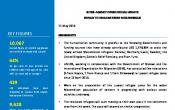Malawi
Operation: Malawi
Location
{"longitude":34,"latitude":-13,"zoom_level":0}
Latest update of camps and office locations 13 Jan 2016. By clicking on the icons on the map, additional information is displayed.
Key Figures
| 2015 end-year results | |
| 1,974 | people of concern who received shelter support |
| 990 | individuals with specific needs that received targeted assistance |
| 5,500 | Women and girls received soap and sanitary pads |
| 74% | of refugee children enrolled in primary education |
| 100% | of people of concern had access to health services |
| 475 | families received farming tools for subsistence farming |
Latest Updates
Last Updated 11 May 2016
People of Concern
15%
Increase in
2015
2015
| 2015 | 23,489 |
| 2014 | 20,373 |
| 2013 | 16,935 |

[["Refugees",9019],["Asylum-seekers",14470]]
Loading ...
Budgets and Expenditure for Malawi
< Back
2015
{"categories":[2012,2013,2014,2015,2016],"budget":[3.47565893,4.43871604,4.41194171,6.24625509,14.05602103],"expenditure":[2.47496269,2.73036648,2.94750217,3.7456183,null]}
{"categories":[2012,2013,2014,2015,2016],"p1":[3.47565893,4.43871604,4.41194171,5.71283409,14.05602103],"p2":[null,null,null,null,null],"p3":[null,null,null,null,null],"p4":[null,null,null,0.533421,null]}
{"categories":[2012,2013,2014,2015,2016],"p1":[2.47496269,2.73036648,2.94750217,3.26069035,null],"p2":[null,null,null,null,null],"p3":[null,null,null,null,null],"p4":[null,null,null,0.48492795,null]}
Loading ...
CHOOSE A YEAR
- 2015
- 2016
Working environment
- Malawi remained politically stable in 2015. However, the country is still ranked among the lowest in terms of development indicators and continued to suffer from economic difficulties following the halting of direct support from external donors to the national budget.
- Major flooding affected more than 17 districts, with more than 200 people killed and many displaced, especially in the southern part of Malawi. UNHCR supported the UN response by providing core relief items for the affected populations.
- The majority of refugees in the country reside in Dzaleka refugee camp, approximately 30 km from the capital Lilongwe. Refugees do not have freedom of movement or the right to work and are dependent on international aid.
- Food rations were reduced by 50 per cent in June 2015, which contributed to protection challenges in the camp and an increase in negative coping mechanisms was witnessed.
- Mixed migratory flows through Malawi towards South Africa also affected the protection environment, prompting increased calls by the government for the relocation of Dzaleka refugee camp to Kasama, Chitipa district, about 700km away from Lilongwe.
Population trends
- As of 31 December 2015, Malawi hosted 25,186 people of concern (PoC) to UNHCR (9,019 refugees and 16,167 asylum-seekers), of whom some 55 per cent are children.
- The majority of refugees and asylum-seekers originate from the Great Lakes region, notably the Democratic Republic of the Congo (11,896) Rwanda (4,816) and Burundi (6,659).
- In 2015, Malawi received an increased number of new arrivals, mainly from the Great Lakes region and Mozambique.
Achievements and impact
- With support from UNHCR, the Refugee Eligibility Committee made first instance decisions for 1,285 cases in 2015, with a recognition rate of 79 per cent.
- 755 refugees departed for resettlement.
- In mid-2015, some 2,000 Mozambicans fled into Malawi following attacks on their villages. The majority returned home but approximately 700 remained. In December, the influx of Mozambicans was again witnessed. UNHCR is supporting the Government to register the displaced and respond to their immediate needs.
- UNHCR participated in the joint UN response to the Malawians affected by flooding early in the year and provided core relief items to displaced families.
Unmet needs
- The increasing numbers of new arrivals in recent years have led to more demands on the social services provided in the camp, resulting in shortages in nearly all sectors.
- While access to health services was provided, there continued to be a shortage of essential drugs.
- Funding constraints resulted in reduced livelihood activities and food rations, leading to increased negative coping mechanisms, including survival sex.
- Education enrolment rates remain low (26% for secondary). This is due to a lack of teachers and classrooms. Classrooms are extremely overcrowded with high teacher-student ratios.
- Only one-third of the population in Dzaleka (some 8,000 people) has access to adequate water.



